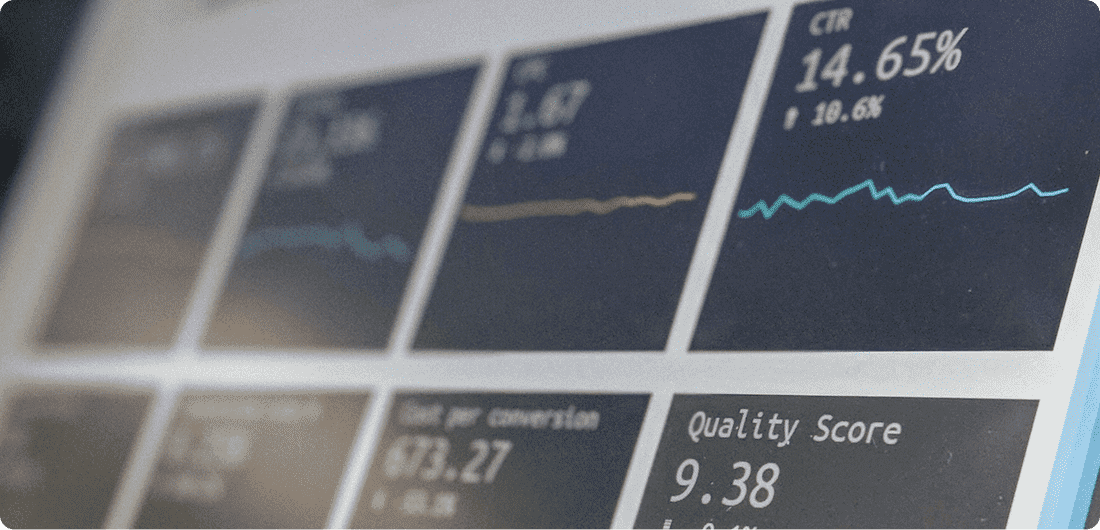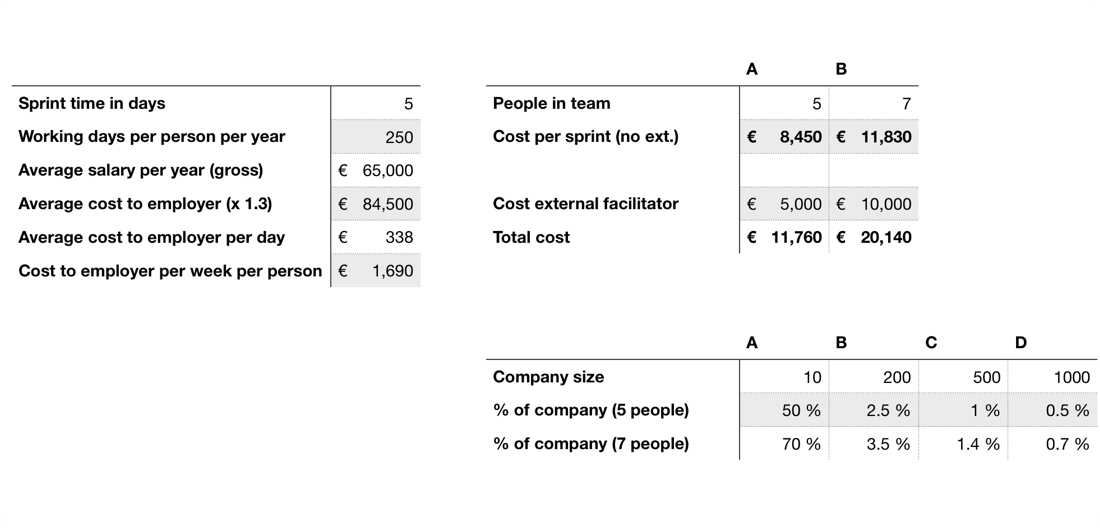The Business Side of Design Sprints
May 27th, 2019 - Written by Andree Huk
A design sprint is not just this creative endeavour that takes 5 days of hard work. No, it must provide a return on investment. In order to calculate the return, we must figure the, firstly, the cost and, secondly, the value provided or generated.
In terms of value provided, Chris Calo at Google sees the value of design sprints in their ability to drive alignment and progress. But how do we quantity "alignment and progress"? Before we explore the value side of design sprints, let's see how we could measure the cost side of such in-person workshops in simple economic terms.
"Chris Calo @Google sees the value of design sprints in their ability to drive alignment and progress."

In fact, the cost side is somewhat easy to measure. It depends, to some degree though, on the size of the company that uses such a (design) method. In a big company such a design sprint is only a small part among many other activities. In smaller companies a sprint may take up everyone’s time for a full week. In any scenario and when viewed from a mid-term perspective, though, such a one-week activity is only 1.92% of a given year (in terms of weeks per person).
Alas, a full one-week activity has a much higher impact within smaller companies.
Who dedicate what time
On a yearly basis, 5 people working one full week would imply a time commitment of 0.96% at a small company of 10. In a bigger company that employs 500 people, a 5-person team would spend about 0.0192% of everyone's time per year. That's a factor of 50.
From a monthly standpoint, the 5-person team in a 10-person company would spend about 5 : (4.33 * 10) = 11.5% (on average a month has 4.33 weeks). For the 500-person company that number is much smaller: 5 : (4.33 * 500) : 4.33 = 0.23%. If you'd consider one week as your timeframe, a sprint requires 5 : 10 = 50% of everyone's time in that small company, and 5 : 500 = 1% in the bigger one.
But what does that mean in terms of hours?
As you already know about 5-7 people take part in such sprints. This group will be fully committed for about 40 hours each, resulting in between 200 - 280 hours in total for a full week. The facilitator prepares the whole sprint ahead of time and and would dedicate about 20-40 hours of her or his time prior to the sprint. The total time commitment would end up to be around 220 - 300 hours (depending on team size). These hours equate roughly to the 1.92% mentioned above (without facilitator hours), of course.
If the company brings in outside support to facilitate the sprint, the time commitment from inside the company would, of course, go down. The cost would then, of course, go up.
An agency would charge about 5,000 - 10,000 EUR for a design lead to facilitate the design sprint. For how this compares to the internal cost of such an initiative, read further.
Crunching the numbers
Let’s review what such an initiatives might actually cost.
To calculate the cost, we will use an average gross salary of 65,000 EUR per year across the participants. The actual average would be distorted by the salary of a department head or CEO (if s/he participates). But let’s leave that aside in order to establish a baseline number here. Now, in order to get to a more real-world type of cost estimate, we have to include additional labour cost a company pays on top of gross salary. We do leave aside internal cost such as benefits, free food or similar, as that differs from company to company.

In Germany, or Spain for that matter, the factor to calculate actual cost is about 1.3 times the employee's gross salary. Please note that this factor depends on the level of gross salary as well as employee specific factors (such as marriage status).
1.3 * 65,000 EUR = 84,500 EUR per person per year
Germany has about 250 working days per year. That’s the number we use to calculate the cost side. For the income side, one would have to subtract holidays and bank holidays. Germany has on average 24 holidays and 11 bank holidays (some may overlap). This would result in about 220 actual working days per employee. Please note that the company, of course, pays the salary no matter whether someone is at the office or on holidays.
Since we want to calculate the cost side, we take 250 days in order to arrive at an average cost per employee per day.
84,500 EUR : 250 = 338 EUR cost per employee per working day
338 EUR x 5 days = 1,690 EUR per employee per sprint week
1,690 EUR x 5 participants = 8,450 EUR
1,690 EUR x 7 participants = 11,830 EUR
The cost for the 5-7 people sprint team would, therefore, be somewhere between 8,450 EUR and 11,830 EUR. If the company likes to engage an external facilitator, the cost would be somewhere between 11,760 EUR on the low end (5 participants) and 20,140 EUR on the high end (7 participants).
The value side of design sprints
It's good to know the cost, but what about what value sprints provide?
Another way to measure such initiatives (the value side) is the ratio of ideas generated to ideas validated (or invalidated). The higher the ratio the better. If your team comes up with 1 idea, builds and tests that same idea, then the ratio is 1 : 1 = 1. On the contrary, if your team comes up with 50 ideas and validates 1, the ratio would be 50 : 1 = 50.
A great aspect about design sprints is that your core team decides on the best idea and executes on it quickly. How often does your company explore, execute and test the ideas generated with real users within a few days’ time?
In Zone To Win Geoffrey Moore writes that a company only has to catch one major product category in a decade in order to spur growth. Let’s do the numbers with these assumptions:
- 1 design sprint per month = 12 sprints per year
- 10 good ideas generated per sprint: 10 x 12 = 120 good ideas per year
- 1 great idea per sprint (1 out of 10) pursued, built and tested: 1 x 12 = 12 per year
- 10% of those great ideas get positively validated and are promising: ~1.2 great ideas per year

You now argue that you only need 1 idea to be generated and tested as in any sprint setting. Well, mathematically that’s true. But how do you know that this 1 single idea is real’ good? Evidence shows that quantity trumps quality. In fact, quantity leads to quality.
Chris Calo @Google: "the ROI of Design Sprints and any other form of in-person workshops" is "to focus a team on one topic for a number of days, they can make progress faster, achieve a more thorough understanding of the problem, and reduce the risk of a complex project stalling."
If you would take Geoffrey Moore’s advise to heart, your company would only need to have 1 stellar idea out of those 12 great ideas per decade. Though, why not 2 out 12? It's likely that you won’t be able to build 12 hugely successful businesses out of these 12 great ideas per decade. We do the numbers: if we would go by what “the market allows to be successful” and assume that roughly 90% of companies go bankrupt after 5-10 years, your company could still have 12 x 10% = 1.25 successful products or businesses per decade.
Putting the numbers in perspective
We saw above that a 5 day design sprint can have internal cost of between 8,450 EUR and 11,830 EUR (no external support). How does this stack up against the amount of ideas generated which we just explored above?
Let’s assume that your team run 1 design sprint each month of a given year. The outcome of of these 12 sprints is 1 stellar idea and 11 OK/good ideas. This one stellar idea costs the company between 101,400 EUR and 141,960 EUR per year. Not cheap, but is it expensive? However, on the flip side it’s hardly possible to envision what kind of successful product or business the team could begin to build out of this 1 “costly” idea. 141,960 EUR laid out over 10 years ain’t that much.
Chris Calo at Google points out that to him "the ROI of Design Sprints and any other form of in-person workshops" is "to focus a team on one topic for a number of days, they can make progress faster, achieve a more thorough understanding of the problem, and reduce the risk of a complex project stalling."
Right on point. We will explore the value side of design sprints in a new article.
What thoughts do you have about the business side of design sprints? Get in touch.
Want to come up with a new digital product, expand your existing business, stay competitive? What's your next step?
Get in touch with Andree Huk
at +49 30 5557 7174 or [email protected].